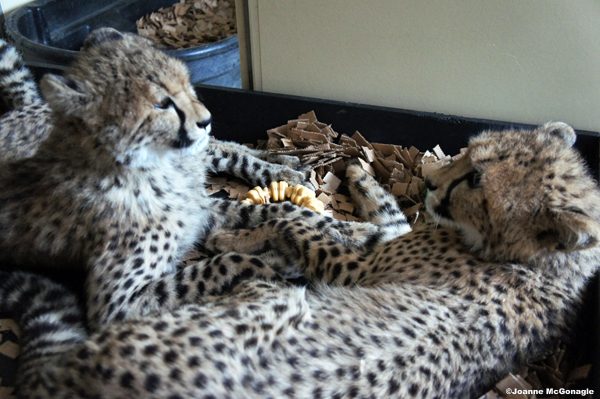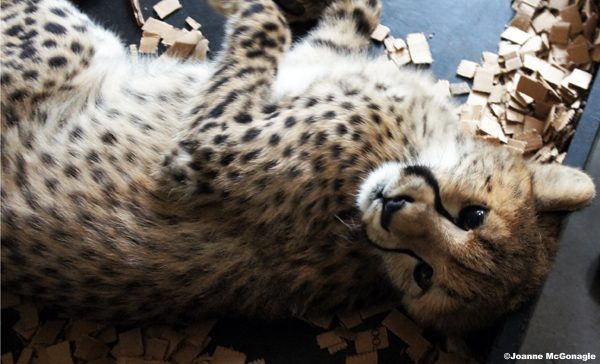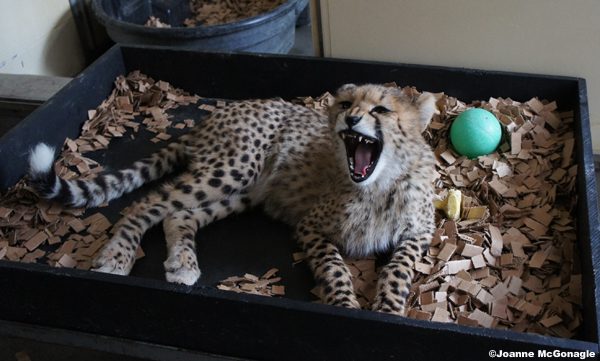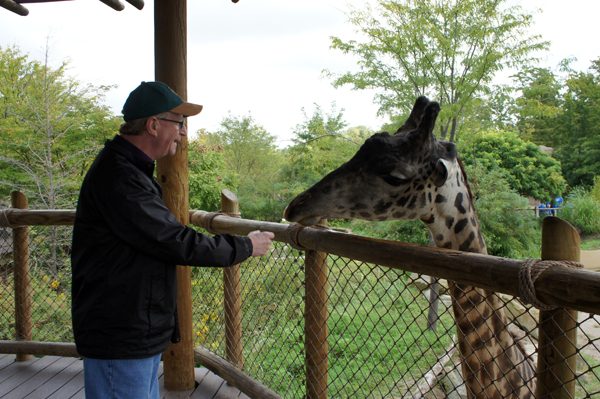
Cheetah Cubs Are Doing Well
Cathryn, Redd and Willow moved to the Cat Show building a couple of weeks ago. Redd’s feeding tube has been removed and he is eating completely on his own. Their trainers’ are focusing on socializing the three cheetah siblings so they can be left alone unsupervised.

Willow
The cheetah cubs were moved to the Cincinnati Zoo Nursery immediately after their mother Willow gave birth by a rare C-section. Sadly, Willow did not survive and the three surviving cubs (there were 3 males and 2 females) remained in the nursery for 12 weeks.

Cathyrn and Willow playing
The cheetah cub trio was reintroduced to Donni, a cheetah cub relocated from the zoo in Oregon, to be raised in Cincinnati. The plan was to keep all four cubs together, but Donni, weighing in at 36 lbs, to the cubs 22 lbs, even though he is only 12 days older, is stronger and bigger than the cubs, so they remain in close but separate quarters.
All the cubs can experience playtime together with the help of nursery dog Blakely. The three siblings and Donni are able to romp and play in the big yard now. The yard is the size of a football field, where the adult cheetahs show off their speed during the Cat Shows.

What a face!
The four Cat Ambassador program trainers provide the cubs with round-the-clock care. The trainers prepare the cubs’ meals, tidy up their living quarters, ( yes…they use a litter pan too), provide a feeling of security and keep them entertained. Paul and I had the honor of meeting the four cubs last week. An unforgettable experience and one for which we are most appreciative.
We look forward to seeing more of Cathyrn, Donni, Redd and Willow and wish them long and happy lives.

That’s a big yawn. Must be nap time.
Before heading out, we stopped by to see John, the African lion. He is quite handsome.

John and one of his cubs
And just because he had never experienced feeding a giraffe, I encouraged Paul to give it a try. He was reluctant at first but as you can see, he rather enjoyed himself!

Paul feeding giraffe
The Cincinnati Zoo’s Angel Fund
The Cincinnati Zoo’s Angel Fund, named after the zoo’s first ambassador, Angel, has directly supported cheetah conservation in Africa. The Angel Fund has contributed more than $1 million to support wild cheetahs from South Africa and Namibia in the south, through Kenya and Tanzania in East Africa.
Cheetahs are endangered, and their population has declined from 100,000 in 1900 to an estimated 9,000-12,000 today. The Cincinnati Zoo is one of nine institutions accredited by the Association of Zoos and Aquariums (AZA) that participate in the Breeding Center Coalition (BCC).
The nine facilities in the cheetah BCC coordinate due dates so if there are single births, or litter mates die, there is a good chance one of the other facilities will already have a litter or be expecting one. Cheetah moms do not raise single cubs, so lone cubs need to be raised by hand or cross-fostered. A cheetah’s unique genetic value, makes cross-fostering the best option. Cheetahs that are raised by humans typically become ambassadors for their species, an important contribution, but do not breed.
What a fantastic update on the cheetah kits.
I have always loved them, striking looks with agility and speed…I am ashamed of the impact we humans have had on the big cats.
Thanks for teaching us so much about them.
Gorgeous big kitties…
whitefish waves two ewe all…….we send de best oh fishez two each of ewe that ya grow big & strong & haza happee healthee long… long… long…… long……long life a head ~~~~~~~~ !! ??
A, E & M…manee thanx two yur mom for sharin thiz post N de fotoz…..they R awesum ???
I’m so glad to hear the three are doing well!
Aww, they are so sweet! Glad to see that they’re growing up strong. Thanks for sharing their story and photos!